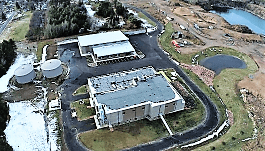New treatment plant addresses PFAS in Wisconsin city’s water supply
March 9, 2023

AWWA Articles
New treatment plant addresses PFAS in Wisconsin city’s water supply
Crews were 18 months into construction of a new water treatment plant in Wausau, Wisconsin, when tests of each of the city’s wells detected forever chemicals above state-recommended levels.
 With that concerning news, staff members hustled to decide what changes needed to be made to the new plant to manage those emerging contaminants. (Pictured right, an aerial shot of Wausau’s new drinking water treatment plant.)
With that concerning news, staff members hustled to decide what changes needed to be made to the new plant to manage those emerging contaminants. (Pictured right, an aerial shot of Wausau’s new drinking water treatment plant.)
“There was a lot of scrambling,” said Eric Lindman, city director of public works and utilities for Wausau. “But everybody has recognized how important this is for generations to come.”
Wausau is about 100 miles northwest of Green Bay and serves around 40,000 people. About a year ago, tests in all six of its wells measured PFAS in excess of current federal health advisory levels.
PFAS, or per- and polyfluoroalkyl substances, are persistent synthetic compounds used in a variety of industrial and consumer products, including nonstick cookware and firefighting foams. They are dubbed “forever chemicals” because of their ability to persist in the environment.
Scientists are studying long-term exposure effects, but research suggests they can lead to health problems such as decreased fertility, developmental delays and increased risk of some cancers. Their presence in drinking water is of increasing public concern.
Wausau officials haven’t determined where the chemicals are coming from, but the Wisconsin River, which recharges the wells, is lined with cities, manufacturing and industry.
“It’s just in everything we use every day,” Lindman said. “From cosmetics, to food wrappings – it’s just so prevalent in our environment and in our lives that I think we’ll be dealing with this for generations.”
While other Wisconsin municipalities have detected PFAS and are treating portions of their source water, Wausau was unique in that the chemicals were so widespread and prevalent in all of the city’s drinking water wells.
Providing short-term, long-term solutions
 After the findings, the city provided filtered water pitchers to residents to remove PFAS at the tap, while the utility began a pilot study to determine the best options for managing the chemicals. The pilot study found that the new facility could remove PFAS with its anion exchange treatment, originally designed for organic carbon removal. It’s a temporary management solution – the system is expensive to maintain for PFAS, at about $800,000 a year, and produces a lot of landfill waste.
After the findings, the city provided filtered water pitchers to residents to remove PFAS at the tap, while the utility began a pilot study to determine the best options for managing the chemicals. The pilot study found that the new facility could remove PFAS with its anion exchange treatment, originally designed for organic carbon removal. It’s a temporary management solution – the system is expensive to maintain for PFAS, at about $800,000 a year, and produces a lot of landfill waste.
The plant went online in December and is successfully removing PFAS from the city’s drinking water. But now, crews are adding a $17 million granular activated carbon (GAC) system to the plant, which should be complete in 2024. The anion exchange process will remain in place and used as originally designed to remove total organic carbon once the GAC system is complete.
Lindman said utility officials chose GAC because of its diversity in removing other emerging contaminants, and because it will produce less waste. Where resin media would potentially need to be sent to the landfill after its lifespan, GAC suppliers are looking at ways to incinerate PFAS and reuse spent carbon media.
Already, other Wisconsin utilities have reached out to Wausau to learn about the plant, and Wausau is sharing information they received from American Water Works Association (AWWA) members and resources to help manage PFAS in drinking water.
“We’ve leaned on so many others for information, and now, hopefully they can lean on us too,” Lindman said.
A hefty financial impact
The effort is one of the largest capital projects in city history, and ratepayers are shouldering much of the expense. The city received $1.6 million in federal funding and is searching for other grants and low-interest loans to help. But the city’s water rates have increased about 30% in the past few years and will continue to go up to help pay for the project, he said.
In hindsight, Lindman said, utility officials should’ve ramped up communication and outreach from the beginning, giving residents a consistent, centralized source of information so they could better understand forever chemicals and appreciate the expense necessary to make such a major treatment plant upgrade.
“There was some anxiety in the community at the beginning, and some of that remains,” he said. “There were a lot of unknowns: How long has this been here? What are you doing to keep the water safe?”
But with evolving PFAS regulations and research, providing those answers proved difficult.
“Our next goals for 2023 and 2024 are to earn that credibility back. We’re here to provide you with absolutely safe water, and we are,” Lindman said. “This is a generational project. It’s fantastic to be part of this.”
Advertisement